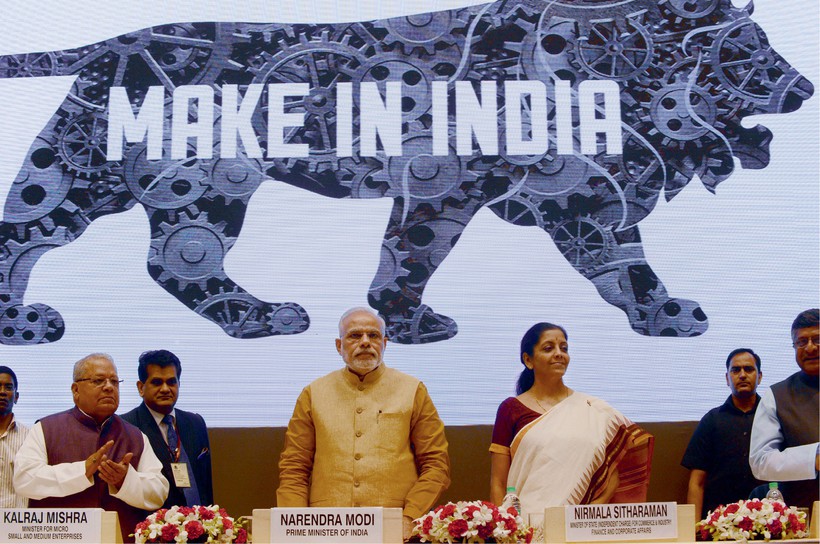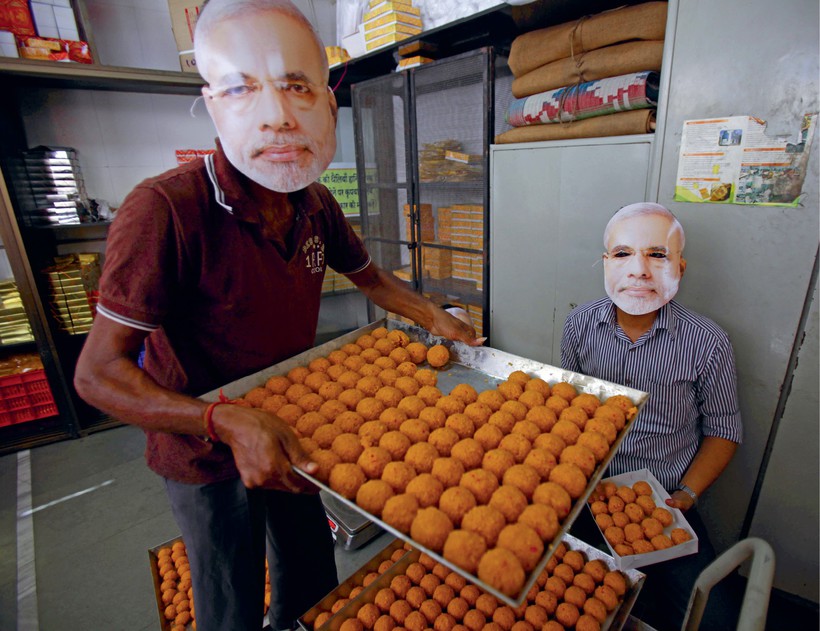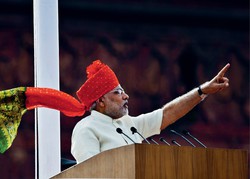Follow Modi, Make in India
Evgeny Pakhomov
On 15 August, Indian Independence Day, Prime Minister Narendra Modi made a meaningful announcement to the global community. “I would like to call people of the world to ‘come, make in India.’ Sell the products anywhere in the world but manufacture here … we have the power, come, I am inviting you.”
In an appeal to his fellow citizens, Modi encouraged Indians to invest in domestic production and promised full support. “This country is yours,” he assured local businessmen. “Thrive here, then think of stepping out – there is a different joy in that. I want Indian companies to become multinational.”
India’s new industrialization program received its official name, ‘Make in India,’ soon thereafter. Modi announced its launch on 25 September, the day after the Indian Space Research Station Mangalyaan entered Mars’ orbit. “Nobody can question the talent of our people … especially after yesterday’s Mars mission,” Modi noted with satisfaction.
The goal of the reforms is to increase the manufacturing sector’s share in the country’s GDP – from below 15% at the time of the announcement to the target of 25% – and return the Indian economy to high growth rates. In essence, the main goal of the Make in India campaign is to strengthen Indian industry, turn the country into a self-sufficient economy, and achieve international recognition. This goal was so important that Modi personally chose the new campaign’s emblem. It includes the Ashoka Chakra wheel from the Indian flag, a symbol of movement and progress, and the lion seen on India’s coat of arms, which symbolizes strength and power.
For the recently elected Prime Minister, who was victorious in elections held last spring, the campaign is another sign of his dedication to the country’s long-overdue reforms. In fact, Modi’s triumph was primarily due to his economic platform. In his former role as Chief Minister of Gujarat, he managed to turn his state into a model of economic success, and then declared his readiness to apply this experience to all of India.
Interestingly, Indians consider the Gujarati people to be especially entrepreneurial, with a natural knack for business. Mahatma Gandhi, the ‘father of the Indian nation’ and the leader of the Indian independence movement was a native of the state, a fact which Modi frequently mentions. But what they expect from Modi, who is now enjoying high popularity both at home and in the rest of the world, is nothing short of a miracle. In recent years, the Indian economy has slowed noticeably – though the country boasted 7-8% annual GDP growth for many years, it began to lose momentum at the end of the 2000s, and dropped to 4.7% in the 2013-2014 fiscal year. Although many countries would love to have economic indicators like that, it is not particularly impressive for Asia, a region developing at breakneck speeds.
India often looks to China, which still maintains high growth rates despite recent difficulties. “Some 15 to 20 years ago, India was trying to compete with China, follow its economic lead, and match their economic indicators,” confirmed chief researcher at the Institute of Oriental Studies, Felix Yurlov, in an interview with BRICS Business Magazine. “But it is now clear that China has taken the lead. India has more poverty, and also suffers from enormous internal problems.”
Modi and his cabinet are fully aware of the problems that have been piling up for decades in India. According to the Indian media, the authorities are already engaged in developing – and in the near future, introducing – a set of laws regulating the labor market and simplifying business regulations. The key industries that will be included in the Make in India campaign have already been identified
According to Yurlov, New Delhi was becoming increasingly aware that it was losing the race to its main rival in the Asia-Pacific region. This was why Modi and his team focused on the economy during the election campaign. Indian experts were concerned with the decline in industrial investment, slow credit growth, and general stagnation in the manufacturing sector. In short, India was in dire need of an economic jolt. And the new Prime Minister was willing to promise his country just that.
Feudal Law
For a long time now, there has been talk of India becoming the new ‘workshop of the world’ and sidelining its eternal rival, China. The country has an abundance of cheap labor (by some estimates, an hour of an average Indian worker’s time is worth three and a half times less than an hour of a Chinese worker’s time (about $1 dollar versus $3.5). In addition, English is one the country’s official languages. This eliminates language barriers, which is particularly important for Western companies. Add to that a large territory and a huge population of young people (more than half of Indians are less than 30-years-old) who are willing to learn, and the overall picture is very favorable.
Nevertheless, the country’s economy is stunted by a number of serious problems that impede rapid growth. Experts most often point to the lack of development of transportation infrastructure, lack of energy, lack of skilled labor, complex and contradictory legislation, as well as the sluggish Indian bureaucracy infamous across South Asia.
Local officials (typically addressed as ‘babu’), have repeatedly thwarted India’s boldest initiatives and are a serious threat to Modi’s modernizing policies, which have the potential to significantly improve the business environment. “India is in urgent need of creating a friendly and predictable environment for business. It is necessary to reduce bureaucratic burdens, introduce tax incentives, and help manufacturers in any way,” confirmed the head of the Indian Cellular Association (ICA), Pankaj Mohindru. According to Mohindru, even Indian cellular communication equipment manufacturers have been moving their production to other countries lately. They are finding countries like Vietnam to be friendlier to investors and manufacturers.
Foreign companies that have ventured into establishing facilities in India in recent decades have faced frequent difficulties and conflicts. Experts still remember the scandals of the 1970s after licenses were revoked from American companies like IBM and Coca-Cola. Twenty years later, the Indian bureaucracy’s contradictory actions have also inflicted huge losses on US energy giant Enron. The company started building a power plant in India in 1992, but the new government put a stop to the project in 1996. The losses amounted to about $3 billion, which had already been invested in construction.
A more recent example of this issue is the sudden and radical redrawing of the telecommunications market, which was carried out by local authorities in 2012. At the time, the Supreme Court of India canceled 122 mobile 2G service licenses that had been issued in 2008 to a number of foreign companies. Some of the victims were Etisalat, Loop, Videocon, Idea Cellular (a foreign shareholder of Axiata), Tata Telecom (DoCoMo), and Uninor (a joint venture with Norwegian Telenor). Another one of the victims was Sistema Shyam TeleServices (SST), the Indian mobile subsidiary of the Russian holding company Sistema JSFC, which instantly lost 21 of its 22 licenses. Appeals in court were unsuccessful; the company had to participate in an auction for frequencies, but only managed to get them in eight telecom districts.
Vice President of Sistema JSFC Vsevolod Rozanov, who was head of SST at the time, said that this highlights the extreme vulnerability of foreign investors in the Indian market. “The government should protect investors who start their own businesses in India in full compliance with the law. No investor will consider doing business in the country without such guarantees,” he said.
Rozanov is sure that this is one area where India is seriously lagging behind its competitors in the region; such legislation has already been enacted and adopted in other countries that rely on foreign investment – China, Vietnam, and Indonesia, among others.
In addition, there still exist many archaic rules and procedures that the country needs to get rid of as quickly as possible. “India has many outdated regulations,” continued Rozanov. “For example, fees are collected for transporting goods across state lines within the country. This is just hellish! Things have started to change, but only very recently. This type of feudalism needs to go.”
Another Russian company that was confronted with the reality of Indian business practices was the heavy-duty truck manufacturer Kamaz. In 2009, long before Modi came to power, Kamaz opened an assembly facility in Hosur, a city 70 kilometers from Bangalore. Prior to this, the site was used to produce Czech Tatra trucks, but their business was moved elsewhere for economic reasons. Kamaz, which had long been eyeing the promising Indian market, outfitted the plant with modern equipment, recruited and trained staff, and started assembling vehicles. But in early 2010, the facility was paralyzed by a strike that lasted several months, and was organized by the radical New Democratic Labor Front (NDLF) leftist union. Activists armed with portraits of Marx, Lenin, Stalin, and Mao simply took over the assembly line one day. They demanded that Kamaz hire of a group of people dismissed by the previous owners of the factory, even though it had not belonged to Kamaz at the time. Kamaz agreed to their demands, and the situation repeated itself in early 2012, when the facility was again taken over by the same union.
The director of Kamaz’s Indian subsidiary Kamaz Motors Ltd., Alexei Agibalov, told BRICS Business Magazine that police didn’t take action until local municipal courts forced their hand. Only then did they intervene, and Kamaz was able to return to normal operation. However, noted Agibalov, the factory is still restricted by the trade union, which is unwilling to accept common standards of productivity and tries to impose its own rules upon the owners. “Labor law in India is hopelessly outdated – some regulations haven’t changed since the beginning of the last century. The interests of the manufacturer are not taken into account, and this situation hinders the development of the industrial sector,” concluded Agibalov.

Agibalov was adamant that India needs to find a balance between the interests of workers and producers. At the same time, he noted that the new Indian prime minister will find it extremely difficult to change the cumbersome nature of the existing system and organize it in such a way that it takes the interests of investors into account. “The fact that Modi was able to set up a rather comfortable environment for business in Gujarat is cause for some optimism. But until legislation across the country is brought into line with modern regulations, the market will not develop as actively as it could,” he said.
The goal of the Make in India campaign, announced by Modi the day after the Indian Space Research Station Mangalyaan entered Mars’ orbit, is to increase the manufacturing sector’s share in the country’s GDP from below 15% to 25%, and return the Indian economy to high growth rates. In essence, it is to strengthen Indian industry, turn the country into a self-sufficient economy, and achieve international recognition
From Words to Deeds
For Modi and his cabinet, remarks like these are nothing new. They are fully aware of the problems that have been piling up for decades in India. According to the Indian media, the authorities are already engaged in developing – and in the near future, introducing – a set of laws regulating the labor market and simplifying business regulations. The key industries that will be included in the Make in India campaign have already been identified. First and foremost will be aviation, the automotive industry, the chemical sector, the pharmaceutical industry, information technology, and tourism, as India anticipates significant and swift breakthroughs in these areas.

There has long been talk of India becoming the new ‘workshop of the world’ and sidelining its eternal rival, China. The country has an abundance of cheap labor. In addition, English is one the country’s official languages. This eliminates language barriers, which is particularly important for Western companies. Add to that a large territory and a huge population of young people (more than half of Indians are less than 30-years-old) who are willing to learn, and the overall picture is very favorable
The objectives of Modi the Reformer do not look completely unattainable, especially considering that, in a sense, he is following a well-trodden path. Indeed, India has already seen a campaign that was meant to change the country. In fact, it was quite successful, although, to a certain extent, it was never brought to its logical conclusion.
By the end of the 1980s, India was on the verge of default, with a weak, non-developing economy and a huge, rapidly growing population. This was the result of the collapse of the economic model that had been used since the country gained independence in 1947.
The founding fathers of the ‘largest democracy on earth,’ including India’s first Prime Minister Jawaharlal Nehru, were not supporters of socialism – at least not in the same sense as their ‘great Soviet brother’ to the north. Still, socialism was discussed at length in Indian society, although the Communist Party of India never seized power and private ownership of the means of production was never banned. Nehru and his colleagues understood socialism as strict state control over business.
The country’s development was overseen by the Planning Commission’s five-year plans. Every business was strictly licensed and operated within the narrow confines of existing regulations. That era in Indian history was even known as the Licence Raj (just as the British Raj was the period of British colonial rule). The government prohibited the closing of unprofitable manufacturing facilities and the laying off of workers, and it was very reluctant to import goods, even as businesses were shackled by absurd restrictions. The level of corruption was incredibly high.
In 1991, in the face of a deep and inevitable crisis, India’s Prime Minister Narasimha Rao was forced to launch a large-scale campaign to liberalize the economy. The government opened the country to foreign capital, held a radical liberalization of licensing rules, allowed the free exchange of the rupee, and repatriation of profits abroad.
As a result, foreign companies entered India en masse, and banks with foreign capital began opening left and right. In the fiscal year 1991-1992, foreign investment in the country amounted to a mere $132 million, but just a few short years later, in 1995-1996, it had shot up to $5.3 billion. Soon the world was talking about the ‘Indian economic miracle,’ and India was among the most dynamically developing countries in the world.
Some 15 years later, economic growth began slowing down once again. The momentum created by the reforms of the early 1990s had waned noticeably. New ideas were needed, and Modi had to come up with them.
The Premier began with a sensational measure – the dissolution of the Planning Commission formed in 1950, which had defined the face of the Indian economy since the days of Jawaharlal Nehru. It is now expected to be replaced by a new structure – the National Institution for Transforming India (NITI), which will include experts and prominent businessmen. Modi even started a forum on Twitter, dedicated specifically to the activities of NITI, which is expected to primarily be an expert and advisory body.
It has also been announced that Modi intends to further open the doors to foreign companies. From now on, foreign investments will be able to be made in sectors previously closed to foreigners – like in railways, for example. In addition, access to India’s defense industry, formerly considered a ‘sacred cow,’ is now possible. Foreign capital can now hold up to a 49% stake in defense companies.
Experts, however, say that this is not enough. Without questioning the sincerity of the Indian Prime Minister, they point out that these measures often lack specifics. “Modi appears to be a sincere person. He really is trying to persuade foreign companies to invest in India and move their manufacturing facilities there. The emotional efforts on the part of the new Indian government are evident. But the problem is that they lack clear substance,” said Rozanov. “Obviously, he is trying to improve the situation. But for the time being, the actions of the government do not feel serious or broad enough. Foreign companies are growing a bit tired of empty promises.”
Moreover, according to Professor C.P. Chandrasekhar of Jawaharlal Nehru University, it is not the right time to start the Make in India campaign. The Hindu newspaper quoted him as saying that India is inviting investments so that the products can be exported, but this might not be possible since a global recession is ongoing. A more effective strategy for the Modi administration, insisted Professor Chandrasekhar, would be a strong focus on strengthening and developing the domestic market.
Experts point out another contradiction in the Premier’s reform program – Modi and his Bharatiya Janata Party claim to be defenders of tradition, but serious changes require drastic measures, which may sometimes be very painful for the traditional Indian economy with its clans and castes. If India is serious about leaping into the 21st century, half-measures simply will not do.
Modi needs to act decisively and judiciously, and not only because India’s economy is in poor shape and the country is losing ground in the global competition. His timeframe is also limited; neighboring China launched a similar campaign aimed at increasing confidence and improving the image of products labeled ‘Made in China.’ The program is not limited to promoting Chinese goods abroad, but is also designed to stimulate the development of high-tech, high-quality products within its borders. Beijing also promises preferred status and tax benefits to these manufacturers.
Given these circumstances, the success of the ambitious Make in India campaign and, to a certain extent, the future of the Indian economy and Modi’s reputation as a reformer, will depend on how consistent the Prime Minister is in his endeavors, and whether he will be able to imbue them with real substance.











